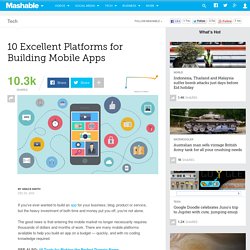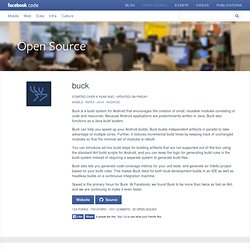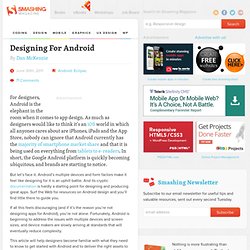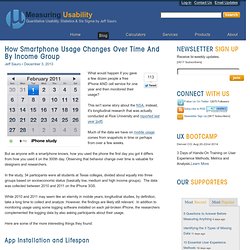

None.cs.umass. Course outline: Have you been following the rise in fitness gadgets such such as Fitbit, Jawbone UP, Nike+ Fuelband, etc, and wondered how they calculate your activity levels and how many calories you have burned each day?

Have you looked at the iPhone or Android App Store and seen the huge number of calorie counting, running, diet tracking, and health monitoring apps, and wondered what it would take to develop such an application? How about the latest health tracking devices and smartwatches including the Apple Watch, Android Wear, and Microsoft Band that go beyond calories and diet, to even monitor your sleep, heart rate, and breathing rate? What about the new revolutionary movement referred to as the Quantified Self?
Mobile App Development with Full-Stack Javascript (part 1 of 4) In this four part blog series, we talk about mobile application development using JavaScript on both front end and backend as a true platform.

Although this concept of full-stack JavaScript is not new, there are limited reference implementations or products that actually exist to develop mobile apps using full-stack JavaScript. In part one of this series, we start with mobile back end developed in Node.js which is a platform for running Javascript on the server. In the next parts, we will talk about the front end, tools for building, deployment, automation, monitoring and optimization.
Recently there has been a lot of adoption for Node.js as a mobile backend acting as glue between front end applications (being built in native, hybrid or mobile web technologies) and the back end data sources. Here we discuss the characteristics of mobile back ends and the benefits of using JavaScript for building them. 10 Excellent Platforms for Building Mobile Apps. If you've ever wanted to build an app for your business, blog, product or service, but the heavy investment of both time and money put you off, you're not alone.

The good news is that entering the mobile market no longer necessarily requires thousands of dollars and months of work. There are many mobile platforms available to help you build an app on a budget — quickly, and with no coding knowledge required. With a small investment, you can create and manage your mobile site or application using one of the platforms listed below, and start reaping the advantages of offering your customers a dedicated mobile experience, including increased awareness, engagement and revenue.
Show As Gallery Have something to add to this story? Image: Mashable composite. iStock, pressureUA. Facebook Code. Started over a year ago · Updated on Friday Buck is a build system for Android that encourages the creation of small, reusable modules consisting of code and resources.

Because Android applications are predominantly written in Java, Buck also functions as a Java build system. Buck can help you speed up your Android builds. Buck builds independent artifacts in parallel to take advantage of multiple cores. Further, it reduces incremental build times by keeping track of unchanged modules so that the minimal set of modules is rebuilt. Test Screener - Mobile Device Testing. Periodic Table of Storytelling. Designing For Android. Advertisement For designers, Android is the elephant in the room when it comes to app design.

As much as designers would like to think it’s an iOS world in which all anyones cares about are iPhones, iPads and the App Store, nobody can ignore that Android currently has the majority of smartphone market share and that it is being used on everything from tablets to e-readers. In short, the Google Android platform is quickly becoming ubiquitous, and brands are starting to notice. But let’s face it. Android’s multiple devices and form factors make it feel like designing for it is an uphill battle. If all this feels discouraging (and if it’s the reason you’re not designing apps for Android), you’re not alone. This article will help designers become familiar with what they need to know to get started with Android and to deliver the right assets to the development team. Android Smartphones And Display Sizes Two common Android screen sizes.
Indigo Studio - wireframing tool - Interaction Design Tool. What Is Color? The Photo Sharing App Everyone Is Talking About. Designing the mobile user experience. IBM Rational Solution Center. How Smartphone Usage Changes Over Time and By Income Group. Jeff Sauro • December 3, 2013 What would happen if you gave a few dozen people a free iPhone AND cell service for one year and then monitored their usage?

This isn't some story about the NSA, instead, it's longitudinal research that was actually conducted at Rice University and reported last year [pdf]. Much of the data we have on mobile usage comes from snapshots in time or perhaps from over a few weeks. But as anyone with a smartphone knows, how you used the phone the first day you got it differs from how you used it on the 300th day.
10 Effective Mobile Design Fundamentals for your eCommerce Website. With the passage of time, more and more people are moving away from desktop onto mobile-optimized websites even for shopping products. Mobile eCommerce experience is an important matter to talk about as it has been found that 67% of people are more likely to make a purchase if their favourite websites can be accessed from their Smartphones.
Therefore, designers are using established design patterns to Kickstart a mobile eCommerce project. Significant development with the mobile designing pattern to boost eCommerce sales has led various businesses to consider mobile eCommerce. So let us focus on the fundamental mobile designing pattern to increase your eCommerce conversion rate. Home pages Make the home page user-friendly rather than focusing on the content. The Navigation Menu Many websites have navigation menus in the header besides using home page as their primary navigational hub.
Pages to Showcase Products There are two common patterns to design a product page. Mobile-Assisted-Shopper-Infographic-Sept2013.